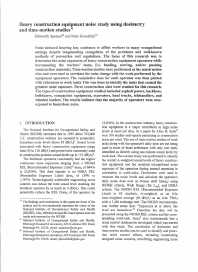Mining Publication: Heavy Construction Equipment Noise Study Using Dosimetry and Time-Motion Studies
Original creation date: July 2007
Noise induced hearing loss continues to afflict workers in many occupational settings despite longstanding recognition of the problems and well-known methods of prevention and regulations. The focus of this research was to determine the noise exposures of heavy construction equipment operators while documenting the workers' tasks, (i.e. hauling, moving, and/or pushing construction material).Time-motion studies were performed at the construction sites and were used to correlate the noise dosage with the work performed by the equipment operators. The cumulative dose for each operator was then plotted with references to work tasks. This was done to identify the tasks that caused the greatest noise exposure. Three construction sites were studied for this research. The types of construction equipment studied included asphalt pavers, backhoes, bulldozers, compaction equipment, excavators, haul trucks, telehandlers, and wheeled loaders. The results indicate that the majority of operators were overexposed to hazardous noise.
Authors: ER Spencer, PG Kovalchik
Peer Reviewed Journal Article - July 2007
NIOSHTIC2 Number: 20032460
Noise Control Eng J 55(4), 2007 Jul-Aug; :408-416
See Also
- Analysis of a Mechanism Suspension to Reduce Noise from Horizontal Vibrating Screens
- Determination of Sound Exposures (DOSES): Software Manual and Implementation Guide
- Heavy Construction Equipment Noise Study Using Dosimetry and Time-Motion Studies
- Noise Assessment of Stone/Aggregate Mines: Six Case Studies
- Results of Noise Measurements from Underground Testing of a Roof Bolting Machine Duty Cycle
- Snapshot of Noise and Worker Exposures in Sand and Gravel Operations
- Sound Restoration Hearing Protection: Genesis of a Standard Test Method
- Technology News 536 - NIOSH Develops New Software to Analyze and Reduce Noise Exposure
- Water Well Safety Bits: Health And Safety Information For The Water Well Industry
- What Does a Hearing Loss Sound Like?
- Content source: National Institute for Occupational Safety and Health, Mining Program


 ShareCompartir
ShareCompartir
